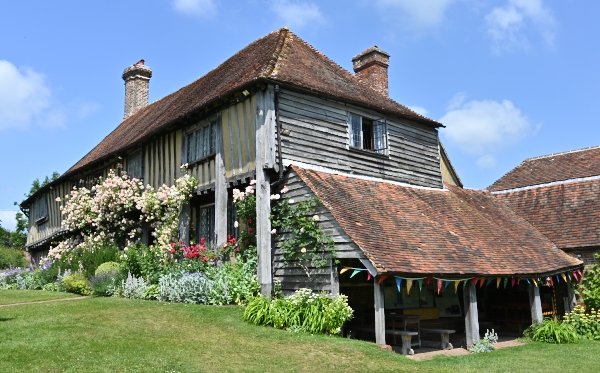By Robert Crouch

I like finding places that are a little different and have an authentic history.
Smallhythe Place, which lies north of Rye on the Kent border with East Sussex is such a place and one the National Trust’s lesser-known gems.
Though you have to park in an adjoining layby on the main road through the village, there were plenty of spaces when I visited. The house was built sometime in the early 16th Century, and is an impressive timber framed building with climbing roses and tall chimneys.
Its location is adjoining what was once a thriving dockyard.
It’s difficult to imagine when you look across the fields, but a ‘hythe’ is a landing place. It provides a clue to Smallhythe’s origins as a dockyard, which began in the late 12th and early 13th Centuries. The tidal River Rother allowed access to the coast and English Channel, 12 miles away.
Some of the great ships of the medieval and Tudor period were built here during the 15th and 16th centuries. These include The Marie, a 100-ton vessel, built in 1410 for Henry IV. Henry V also visited Smallhythe to see the construction of two ships he’d commissioned.
In 1545-6, Henry VIII ordered The Grand Mistress and The Great Gallyon to be built at Smallhythe. These were the last of the royal ships to be built there.
The river was silting up, preventing the passage of ships to the dockyard. When the upstream Knelle Dam collapsed in the mid-17th Century, it signalled the end of the port and shipyard.
The community of Smallhythe, which was mainly employed in the shipbuilding industry, struggled to find employment after the demise of the dockyard.
Smallhythe Place was probably used by local port officials, or as an office for a local shipbuilder. It may also have enjoyed a spell as an inn or courthouse.

In 1899, Ellen Terry bought the house and grounds. She was an unconventional Shakespearian actor, who gave many superlative performances of his iconic female leads during a career that spanned 60 years. She was the first female actor to be made a dame.

The house is pretty much as she left it when she died in 1927. If you enjoy delving into the history and lives of the people who lived there, the interior’s like a time capsule. It’s filled with original furniture, curiosities, costumes such as the iconic Beetlewing, and media memories that provide fascinating insights into her life, in and out of the theatre.

Ellen liked to surround herself with family and friends, many of whom were fellow actors. Her daughter, Edy Craig, a prolific theatre director, producer and costumier, lived next door in the Priest House.
On Ellen’s death in 1928, the house passed to Edy. She turned the house into a memorial museum to commemorate her mother’s life and career. In 1929, she converted the late 17th-century thatched barn in the garden into a theatre, which still hosts plays to this day.

On the 21st July 1929, a year after Ellen Terry’s death, the theatre opened to the public. Edy chose the play, made the costumes, oversaw the set designs and rehearsed the cast. Every July and August, there’s an annual commemorative performance of a different Shakespeare classic.

Outside, the tranquil gardens, which include an orchard and ponds, are perfect for wandering and enjoying the wildlife. At the top of the long garden, a herb garden sits in front of the Writing Hut.

After digging deep into the history of the village and Ellen’s illustrious career and memories, the garden is the perfect setting to relax and roam and enjoy what once drew Ellen to the place. While not overly ornate or manicured, the gardens are beautiful and peaceful, with many colourful and interesting plants and trees to discover as you ramble.

Finally, armed with a cup of tea and a slice of cake, you can sit in the garden and imagine the tall ships that once sailed in and out of the harbour next door.
